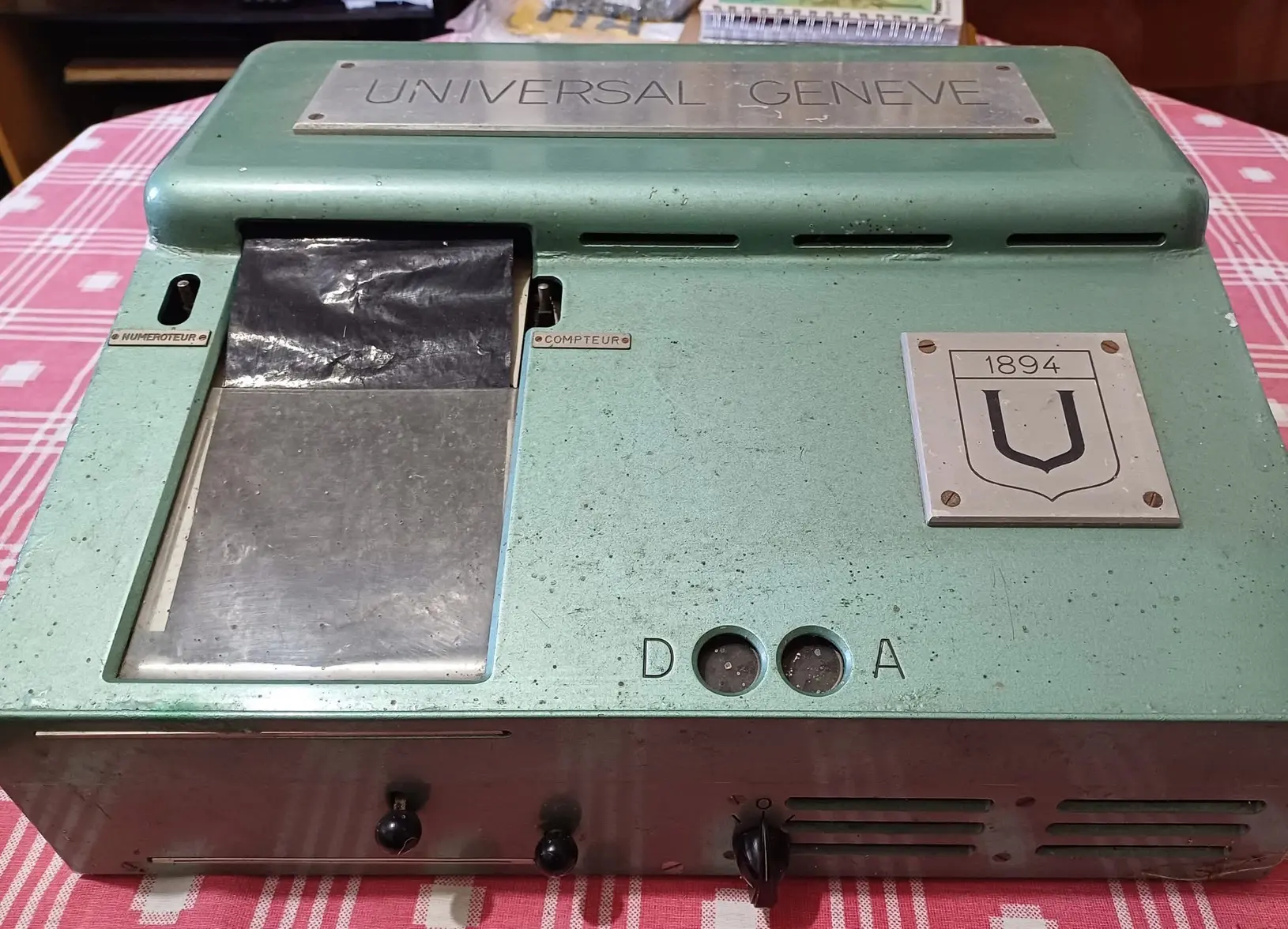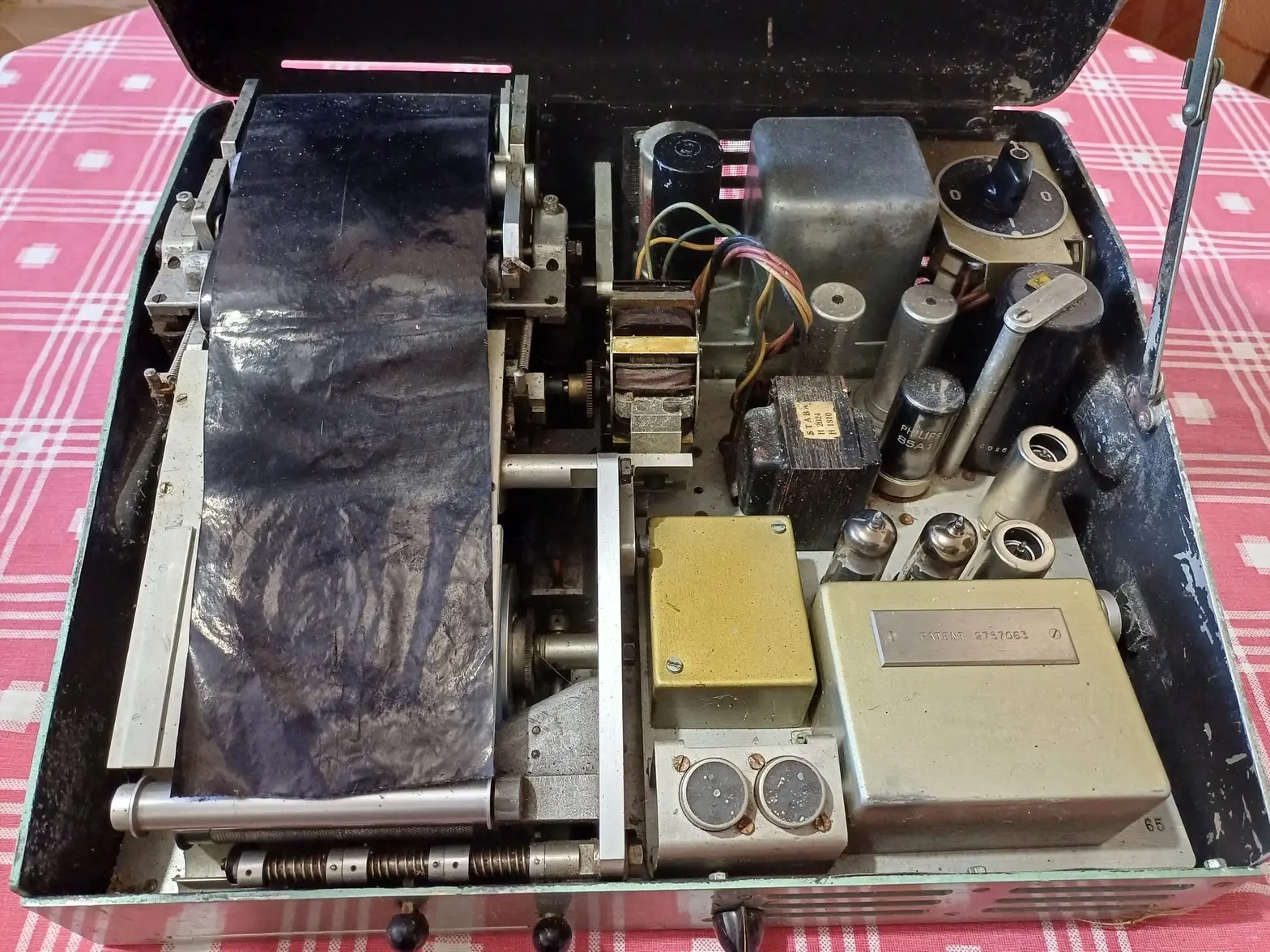UG Machine Info
ErichKeane
·There is a lot hidden there by both the carbon paper and the boxes/etc, BUT: I suspect it is some sort of timegrapher.
Looking up the patent listed, that is actually a US patent number I suspect is this one: https://ppubs.uspto.gov/api/pdf/dow...mLTQ2ZGQtYmMxOS0yNGNmOTk4MzY2NDgiLCJleHAiOjB9
It is a "Timekeeping Apparatus with Printed Times" issued to Georges Pagnard of Moutier, Switzerland, assigned to Omega Louis Brant & Frere SA Bienne Switzerland. Based on my poor reading of it, it looks to be effectively a stopwatch mechanism that then turns some numbers to be printed on the left?
The top right has what looks like some sort of amplifier circuit, so my suspicion is that it is doing some sort of timing of events based on what look to be speakers at the front?
BUt that is my best guess from what I can see.
Looking up the patent listed, that is actually a US patent number I suspect is this one: https://ppubs.uspto.gov/api/pdf/dow...mLTQ2ZGQtYmMxOS0yNGNmOTk4MzY2NDgiLCJleHAiOjB9
It is a "Timekeeping Apparatus with Printed Times" issued to Georges Pagnard of Moutier, Switzerland, assigned to Omega Louis Brant & Frere SA Bienne Switzerland. Based on my poor reading of it, it looks to be effectively a stopwatch mechanism that then turns some numbers to be printed on the left?
The top right has what looks like some sort of amplifier circuit, so my suspicion is that it is doing some sort of timing of events based on what look to be speakers at the front?
BUt that is my best guess from what I can see.
Joca
·Some of mine initial "chat GPT" findings:
The unit is confirmed as a 1950s chronocomparator - a laboratory-grade timing and regulation system used by Universal Genève and its authorized ateliers for chronometric testing and adjustment of mechanical watch movements.
1. Confirmed Identification
The machine is a fully integrated timing recorder, combining an acoustic amplifier, mechanical chart recorder, beat comparator, and numbering system. It operates similarly to contemporary Greiner, Witschi, or LeCoultre Chronocomparators but bears Universal Genève’s custom branding (“UNIVERSAL GENEVE” plate and 1894 crest). It was used for professional chronometry tests, not consumer or retail service.
2. Newly Observed Control Panel Functions
Recent close-up images revealed a secondary control panel with four labeled rotary connectors and one auxiliary output. These provide key insights into the machine’s operational logic:
• DÉPART - engages the paper feed clutch to begin timing.
• ARRIVÉE - stops the paper feed and finalizes the test.
• COMPTEUR - activates or resets the internal beat/time counter circuit.
• 6 V - - auxiliary DC power output for the external microphone pickup or accessory probe.
• NUMÉROTEUR - drives a mechanical numbering solenoid that stamps sequential test numbers on the recording tape.
These labels are in French, consistent with Swiss laboratory nomenclature of the 1950s. The presence of DÉBRAYAGE (clutch release) confirms a mechanical disconnection system used to thread or remove paper rolls safely.
3. Functional Overview
The machine’s workflow reflects the precision procedures used in Universal Genève’s chronometry departments:
1. Place the movement on the microphone pickup and select the correct beat rate.
2. Press DÉPART to engage the clutch and start the paper feed.
3. The NUMÉROTEUR stamps a sequential ID on the chart.
4. The trace is recorded as the escapement ticks, showing rate and beat error.
5. The COMPTEUR records elapsed time or beat count.
6. Press ARRIVÉE to stop and finalize the run.
7. Use DÉBRAYAGE to disengage the paper rollers for chart removal.
The “D O A” indicator windows on the front panel (likely “Retard / On-time / Avance”) give real-time feedback on whether the movement is running slow, on rate, or fast.
4. Internal Components (Based on Visual Evidence)
The machine uses vacuum-tube electronics, including a Philips 85A2 voltage regulator and a transformer-coupled amplifier stage, typical of early-1950s chronometry devices. The heavy metal chassis, large paper transport mechanism, and synchronized numbering unit match Swiss laboratory standards of the period. The entire setup was engineered for stability, accuracy, and repeatability over long-duration tests.
The overall layout indicates collaboration with a specialized manufacturer, likely Greiner or LeCoultre Instruments, which produced similar professional chronocomparators that brands such as Omega, Longines, and UG rebranded.
5. Historical Context and Provenance
During the 1950s, Universal Genève was renowned for its chronometric precision, producing chronometer-grade movements such as the Microtor and Polerouter series. Machines like this one were used both for factory quality control and for observatory-level testing. Each tested watch would generate several paper charts—numbered by the Numéroteur—archived alongside calibration records.
The use of proprietary branding and bilingual French labels confirms it as an in-house or authorized service instrument, rather than a generic supplier unit.
6. Collectability and Preservation Notes
Few Universal Genève-branded timing machines survive. Most were dismantled when solid-state Witschi timers replaced paper-record systems in the 1970s. This surviving unit, with intact plates, glass, and internal tubes, represents a rare industrial artifact of mid-century Swiss horological engineering.
If restoration is considered, proceed carefully:
• Use a Variac to reform capacitors gradually.
• Replace aged electrolytics before applying full voltage.
• Clean and lubricate the paper feed rollers and numbering mechanism.
• Retain original patina—over-restoration diminishes historical value.
This instrument is now best preserved as a display-grade relic of Universal Genève’s golden era.
Conclusion
The Universal Genève machine is conclusively identified as a mid-1950s chronocomparator and chart recorder, customized for use in the company’s precision laboratories. The additional controls labeled “DÉPART,” “ARRIVÉE,” “COMPTEUR,” and “NUMÉROTEUR” confirm it as a professional instrument capable of automated testing, recording, and serial documentation of mechanical watch performance. It stands as a remarkable witness to the technological sophistication that defined Universal Genève’s chronometric excellence.
The unit is confirmed as a 1950s chronocomparator - a laboratory-grade timing and regulation system used by Universal Genève and its authorized ateliers for chronometric testing and adjustment of mechanical watch movements.
1. Confirmed Identification
The machine is a fully integrated timing recorder, combining an acoustic amplifier, mechanical chart recorder, beat comparator, and numbering system. It operates similarly to contemporary Greiner, Witschi, or LeCoultre Chronocomparators but bears Universal Genève’s custom branding (“UNIVERSAL GENEVE” plate and 1894 crest). It was used for professional chronometry tests, not consumer or retail service.
2. Newly Observed Control Panel Functions
Recent close-up images revealed a secondary control panel with four labeled rotary connectors and one auxiliary output. These provide key insights into the machine’s operational logic:
• DÉPART - engages the paper feed clutch to begin timing.
• ARRIVÉE - stops the paper feed and finalizes the test.
• COMPTEUR - activates or resets the internal beat/time counter circuit.
• 6 V - - auxiliary DC power output for the external microphone pickup or accessory probe.
• NUMÉROTEUR - drives a mechanical numbering solenoid that stamps sequential test numbers on the recording tape.
These labels are in French, consistent with Swiss laboratory nomenclature of the 1950s. The presence of DÉBRAYAGE (clutch release) confirms a mechanical disconnection system used to thread or remove paper rolls safely.
3. Functional Overview
The machine’s workflow reflects the precision procedures used in Universal Genève’s chronometry departments:
1. Place the movement on the microphone pickup and select the correct beat rate.
2. Press DÉPART to engage the clutch and start the paper feed.
3. The NUMÉROTEUR stamps a sequential ID on the chart.
4. The trace is recorded as the escapement ticks, showing rate and beat error.
5. The COMPTEUR records elapsed time or beat count.
6. Press ARRIVÉE to stop and finalize the run.
7. Use DÉBRAYAGE to disengage the paper rollers for chart removal.
The “D O A” indicator windows on the front panel (likely “Retard / On-time / Avance”) give real-time feedback on whether the movement is running slow, on rate, or fast.
4. Internal Components (Based on Visual Evidence)
The machine uses vacuum-tube electronics, including a Philips 85A2 voltage regulator and a transformer-coupled amplifier stage, typical of early-1950s chronometry devices. The heavy metal chassis, large paper transport mechanism, and synchronized numbering unit match Swiss laboratory standards of the period. The entire setup was engineered for stability, accuracy, and repeatability over long-duration tests.
The overall layout indicates collaboration with a specialized manufacturer, likely Greiner or LeCoultre Instruments, which produced similar professional chronocomparators that brands such as Omega, Longines, and UG rebranded.
5. Historical Context and Provenance
During the 1950s, Universal Genève was renowned for its chronometric precision, producing chronometer-grade movements such as the Microtor and Polerouter series. Machines like this one were used both for factory quality control and for observatory-level testing. Each tested watch would generate several paper charts—numbered by the Numéroteur—archived alongside calibration records.
The use of proprietary branding and bilingual French labels confirms it as an in-house or authorized service instrument, rather than a generic supplier unit.
6. Collectability and Preservation Notes
Few Universal Genève-branded timing machines survive. Most were dismantled when solid-state Witschi timers replaced paper-record systems in the 1970s. This surviving unit, with intact plates, glass, and internal tubes, represents a rare industrial artifact of mid-century Swiss horological engineering.
If restoration is considered, proceed carefully:
• Use a Variac to reform capacitors gradually.
• Replace aged electrolytics before applying full voltage.
• Clean and lubricate the paper feed rollers and numbering mechanism.
• Retain original patina—over-restoration diminishes historical value.
This instrument is now best preserved as a display-grade relic of Universal Genève’s golden era.
Conclusion
The Universal Genève machine is conclusively identified as a mid-1950s chronocomparator and chart recorder, customized for use in the company’s precision laboratories. The additional controls labeled “DÉPART,” “ARRIVÉE,” “COMPTEUR,” and “NUMÉROTEUR” confirm it as a professional instrument capable of automated testing, recording, and serial documentation of mechanical watch performance. It stands as a remarkable witness to the technological sophistication that defined Universal Genève’s chronometric excellence.
bgrisso
·Very cool ! Does it work ?! It would amazing to have it running.
magana_manuel
·Wow super cool!!
Similar threads
- Posts
- 67
- Views
- 5K
- Posts
- 11
- Views
- 1K



